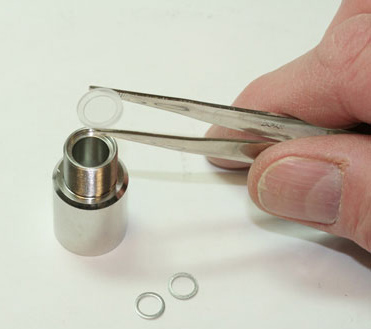Indium Vacuum, Hermetic and Cryogenic Seals

Indium Vacuum, Hermetic and Cryogenic Seals
Due to its softness and compressibility, indium is ideal for use in creating a seal.
Let's get right into it:
Indium foil is commonly used to create seals. The foil is made into an endless variety of shapes and sizes to fit the application. Crucial to the seal is the thickness of the foil, because, if the volume of indium is insufficient, the seal will eventually fail - due to lack of indium to fill in the gaps.
Indium wire is also a form used in the creation of a vacuum, hermetic or cryogenic seal. Care must be taken to insure that the correct diameter of wire is used to make the seal. Too small of a diameter, the gap will not be adequately filled leaving the seal area vulnerable to leaks. Too large, and the indium, when compressed, will exit the seal area and may interfere with other electronics in the area.
When using wire, care must be taken to have
the wire centered in the area to be sealed.
If the wire is off-centered, it may not create an adequate seal when
compressed due to non-uniformity. In some cases, it is beneficial to make a
small groove in the seal area so the wire can be placed using the groove as a
guide for accurate placement.
Not all seals require the same level of
performance. A purity of 99.99% indium is adequate for a vacuum, hermetic or
cryogenic seal, but higher purities are also available if needed. Some seals need to maintain their integrity
for many years while others only need to hold for a short period of time. Develop
your design based on what you know about the application. The more critical
seals will need to be made following the procedure outlined below to insure
that the integrity requirements are met.
Indium is self-passivating and will form
about 80-100 Angstroms of oxide on its surface, at room temperature. In more
critical seal applications, it is essential that this oxide layer be removed
prior to creating the seal because, if the oxide is present during the compression
of the indium, the oxide will be pushed below the surface and could create a
path for leakage.
The following oxide removal procedure should be followed and applies to both indium foil and wire:
1). Degrease the indium in acetone to remove any surface organics that could interfere with the seal.
2). Place the indium in 10% HCl for about 1 minute to remove the oxide on the surface.
3). Rinse thoroughly in DI water to remove the HCl.
4). Rinse in acetone to remove the water.
5). Blow dry with dry nitrogen or allow to air dry.
Caution:
Indium will cold weld to itself, especially
after the surface oxides have been removed. Care must be taken that the indium
is not allowed to touch other freshly etched pieces of indium, as they will
stick together similar to Contact Cement. Separation is difficult, if not
impossible, without damaging the indium piece.
After the indium is ready to use, care must be taken in the proper placement of the foil or wire on the surface to be sealed. Once the indium is in place, the amount of pressure required to make the seal is dependent on the application. A few trials may be required until just the right amount of pressure is determined to form the seal that is needed. These trials are also a good time for adjustments to be made in the thickness of the indium used.
